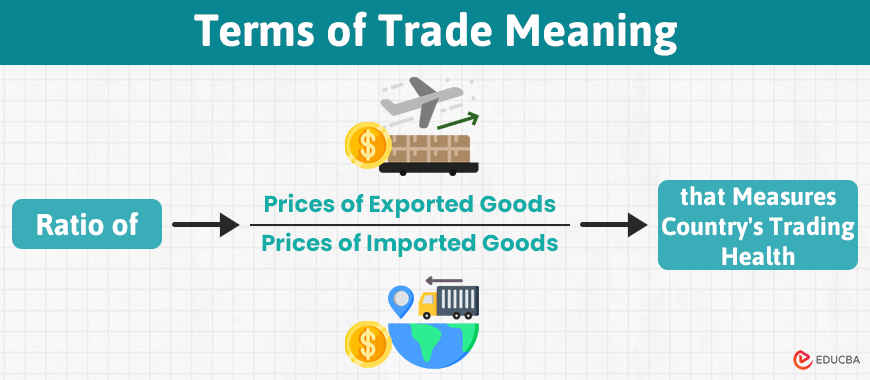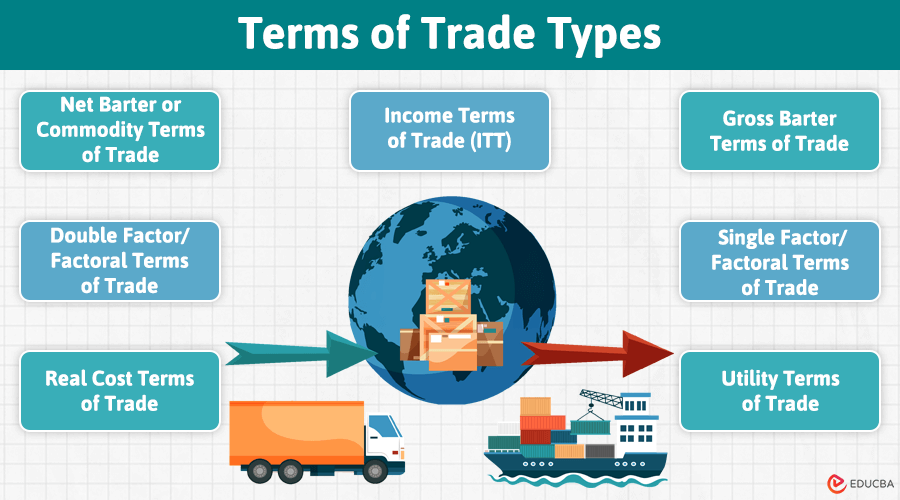Terms of Trade Meaning
Terms of Trade (TOT) in economics refer to the ratio between the country’s export and import prices. It is basically a measure of how much stuff one country can get in exchange for what it sells. The American economist, Frank William Taussig, coined the term in his book ‘International Trade.’
Table of Contents
- Meaning
- Explained
- How to Calculate?
- Types
- Factors Affecting TOT
- Effects of Tariff on TOT
- Importance
- Limitations
- TOT Vs. Balance of Trade
Terms of Trade Explained
Terms of Trade measures of a country’s trading health. Here’s a simplified breakdown:
- Increasing TOT: If the TOT rises above 100%, the country earns more from its exports than it spends on imports. It means more money is coming into the country, leading to wealth accumulation.
- Declining TOT: If the TOT falls, the country is spending more on imports than it earns from exports, meaning more money is flowing out of the country than coming in.
It means, increasing TOT allows countries to get more imports for the same amount of exports, which is beneficial. Conversely, a worsening TOT means fewer imports for the same exports, which is less favorable. This ratio helps gauge how well a country is performing in international trade.
For example, as per the Australian Bureau of Statistics, in 2023 December, Australia’s TOT went up from 94.7 to 94.9 (0.2%). It was due to Australia increasing its prices for exported goods. It shows Australia is improving its TOT ratio.
How to Calculate? Formula + Example
The simplest way to calculate terms of trade is to divide the price of exported goods by the price of imported goods and then multiply the result by 100.
Formula:
OR
Example:
Let us understand the concept of the Term of Trade with a simple example.
Consider Country A, which has an export index of 120 and an import index of 108.
Terms of Trade = Index of Export Prices / Index of Import Prices x 100
= (120/108) x 100
= 111.11%
We can conclude that Country A has positive terms of trade since the result is 11% above 100. It means Country A is selling more exports and importing less.
However, there are many types of terms of trade in economics, and each uses a different equation to calculate each type.
Types
#1. Net Barter or Commodity
The Net barter or Commodity term of trade is the most common type of term of trade.
Formula:
Where,
- is the index value of imports.
- is the index value of exports.
#2. Income Terms of Trade (ITT)
Developed by G.S.Dorrance, this is an improved version of the Net Barter term of trade. It measures how much a country can import. The ratio is higher if:
- A country exports more
- Has higher export prices
- Sees lower import prices.
Formula:
OR
Where,
- is the price of exports.
- is the quantity of exports.
- is the price of imports.
#3. Gross Barter
Instead of comparing prices like the net barter TOT, gross barter TOT calculates the ratio of the quantities of import and export.
Formula:
Where,
- Qm is the quantity of imports.
- Qx is the quantity of exports.
#4. Single Factor/Factoral
Since the Net Barter Terms of Trade do not account for changes in how efficiently a country produces export goods, Prof. Viner developed the Single Factor Terms of Trade. In this, we multiply the net barter TOT with the productivity index of domestic exports.
Formula:
OR
Where,
- is the price of exports.
- is the price of imports.
- or is the productivity index of domestic exports.
#5. Double Factor/Factoral
Like in single factoral TOT, we consider productivity change for domestic exports, in double factoral terms of trade we consider productivity change of both domestic exports and international exports (aka domestic imports).
Formula:
Where,
- is the price of exports.
- is the price of imports.
- is the productivity index of international exports or domestic imports.
- is the productivity index of domestic exports.
#6. Real Cost
It measures the amount of labor or resources a country uses to produce its exports compared to its imports. It assesses the efficiency and economic advantage in trade by considering the actual production costs rather than just prices.
Formula:
Where,
- is the single factor terms of trade.
- is the real cost of producing exports.
#7. Utility
It assesses trade by comparing the satisfaction or benefits a country gains from its imports to what it gives up in exports. It focuses on the qualitative advantages of trade, such as improved well-being, rather than just financial value.
Formula:
Where,
- is the real cost terms of trade value.
- U measures how valuable imports are in comparison to exports.
Determinants or Factors Affecting Terms of Trade
The several factors that can affect the Term of Trade are as follows:
- Inflation Rate: Higher inflation can make its exports more expensive, decreasing TOT.
- Exchange Rates: A weak domestic currency makes exports cheaper and imports expensive, potentially improving TOT.
- Global Demand: Higher global demand for a country’s exports can enhance the TOT.
- Quality and Size of Goods: Higher quality products with higher prices can improve TOT.
- Supply: Natural disasters or innovations that affect production can alter TOT both positively and negatively.
- Trade Policies: Tariffs, quotas, and trade agreements can directly impact the TOT by making imports and exports more or less expensive.
Effect of Tariffs on Terms of Trade
Tariffs (taxes imposed on imported goods) can significantly impact a country’s Terms of Trade. Here’s how:
- It leads to an increase in import prices, which, in turn, improves TOT.
- Higher import prices may also lead consumers to buy more domestically produced goods, boosting local industries. It can potentially lead to increased production and exports, which may improve the TOT.
- Other countries may impose their own tariffs on the first country’s exports, worsening its TOT.
- Tariffs can increase production costs and reduce the competitiveness of exported goods, potentially worsening the TOT.
- A country with significant economic power may use tariffs to negotiate better trade terms.
Importance
- It serves as a crucial economic indicator that helps assess a country’s trading position, economic health, and performance in international trade.
- Governments and policymakers use TOT to design and implement trade policies like tariffs, subsidies, and other trade-related measures.
- It helps allocate resources efficiently by indicating which sectors are more competitive internationally.
- It helps countries bargain better terms in trade agreements and international trade negotiations.
- A favorable TOT can contribute to economic growth by increasing export revenues.
Limitations
- Short-term fluctuations, such as temporary supply shocks or changes in global demand, can easily influence TOT.
- Volatile and fluctuating commodity prices can lead to unstable economic conditions.
- It focuses on traded goods and services, ignoring non-traded sectors.
Terms of Trade Vs. Balance of Trade
| Aspects | Terms of Trade | Balance of Trade |
| What is it? | TOT compares the prices of a country’s exports to the prices of its imports. | BOT shows the difference between how much a country exports versus imports over a period. |
| Why it Matters? | It indicates how many units of imports a country can get for each unit of export. | It indicates whether a country has a trade surplus (exports > imports) or a trade deficit (imports > exports). |
| What Does it Measure? | It measures a country’s trading health and efficiency in international trade | It measures a country’s economic transactions with the rest of the world. |
| How to Interpret? | If it improves, the country can import more goods for the same amount of exports, indicating a favorable trade position. | A positive BOT (trade surplus) means the country exports more, while a negative BOT (trade deficit) means the country imports more. |
Recommended Articles
We hope this detailed article on terms of trade helps you understand the concept. Here are other economic articles you may find useful.




